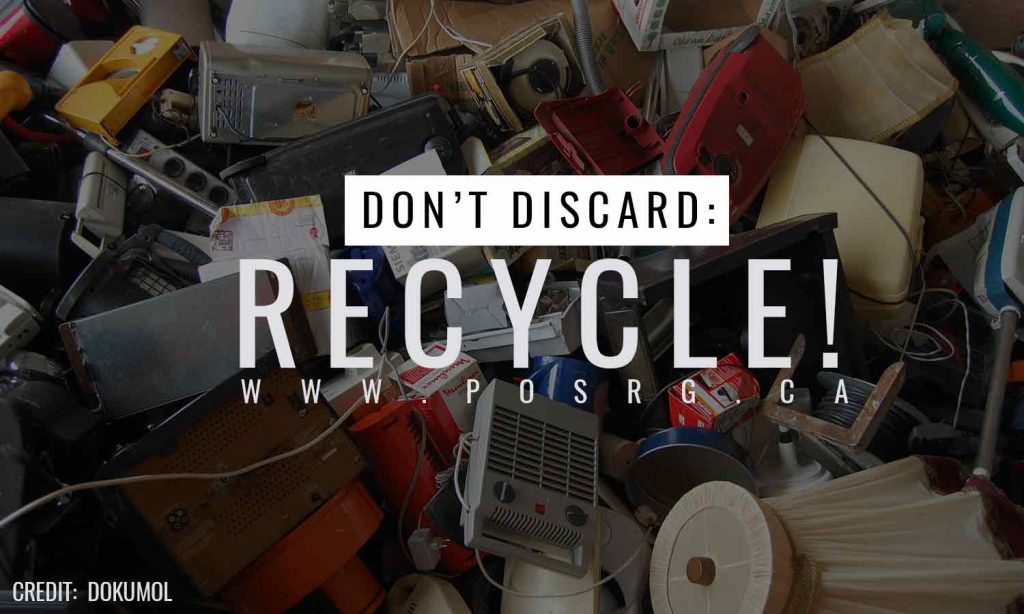Global consumerism and packaging has produced an astronomical amount of waste that continues to grow, resulting in pollution and, now, landfill shortages. With a near-worldwide love for acquiring the latest and most advanced gadgets and chucking out old ones, electronic waste (or e-waste) is a large contributor to the landfill problem. To address this issue, initiatives for proper e-waste management and recycling have been put in place.
According to the “Global E-Waste Monitor 2017” (produced by United Nations University), the total e-waste worldwide in 2016 amounted to a total of 44.7 million metric tons — and only 20% of that waste was recycled through proper channels. This number is predicted to continue on an upward trend of 3-4 percent per year.
Defining e-Waste
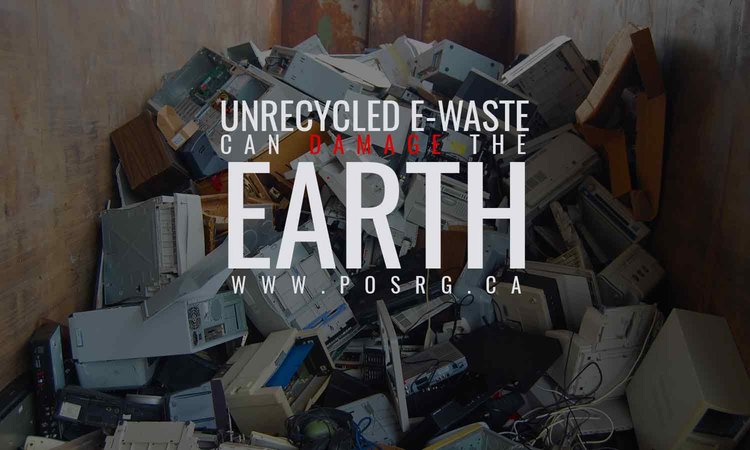
E-waste is any equipment or appliance (approaching the end of its shelf-life) used in both residential and commercial venues. There are presently nine Canadian provinces requiring Extended Producer Responsibility (EPR), which dictates that producers oversee the post-consumer stage of a product.
The type of electronics that can be recycled depends on each region. Generally (according to the Environment Canada), the list of recyclable equipment includes items like:
- Display devices (e.g. televisions and monitors)
- Laptop and desktop computers (including servers and computer terminals)
- Audio, video, and gaming devices (e.g. CD/DVD players, projectors, and video recorders)
- Photocopiers, scanners, and printers
- Telecom equipment (e.g. telephones and answering machines)
- Peripheral devices (e.g. mouse, keyboard, and flash drives)
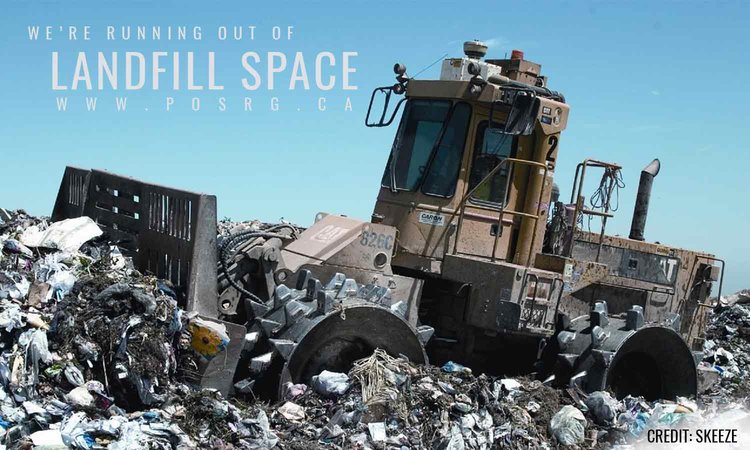
The Significance and Impact of Proper E-Waste Management
The continued growth of e-waste volume raises various major concerns:
- Insufficiency of landfill space – Around the world, only 15% to 20% of e-waste is recycled. What isn’t recycled ends up in landfills. Unfortunately, that space is limited, so excess waste often spills over into oceans and other waterways.
- A shortage of mineral resources – The demand for virgin materials has taken a toll on the mining industry. Ore grade is declining around the world, resulting in a shortage of materials, making the electronic industry more difficult to sustain.
- Increased risks to human health – Electronics contain certain components (like batteries) that are hazardous. If not disposed of properly, these materials can compromise natural resources. They, in turn, can contaminate food and water — putting the lives of both humans and animals in danger. Hazardous materials in e-waste include:
- Chemical substances
- (e.g. phosphors and ozone-depleting substances)
- Toxic metals (e.g. mercury, lead, and cadmium)
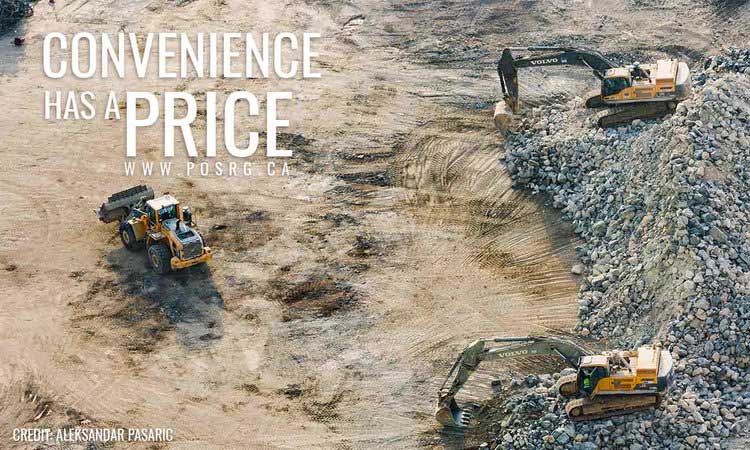 To mitigate these problems, a number of nations are beginning to acknowledge the need for proper e-waste management and enact effective measures. By doing so, we are able to:
To mitigate these problems, a number of nations are beginning to acknowledge the need for proper e-waste management and enact effective measures. By doing so, we are able to:
- Preserve non-renewable resources – Recovering viable materials from e-waste can minimize the impact on both the mining industry (and the Earth itself).
- Refrain from adding to pollution – We can alleviate the landfill problem and reduce the risk of hazardous materials seeping into important resources and harming living organisms.
- Save on energy consumption – Recycling various materials consumes less energy compared to mining, processing, and manufacturing virgin materials.
- Reduce greenhouse gas emissions – By reducing the energy needed to procure virgin materials, e-waste management can lessen our carbon footprint.
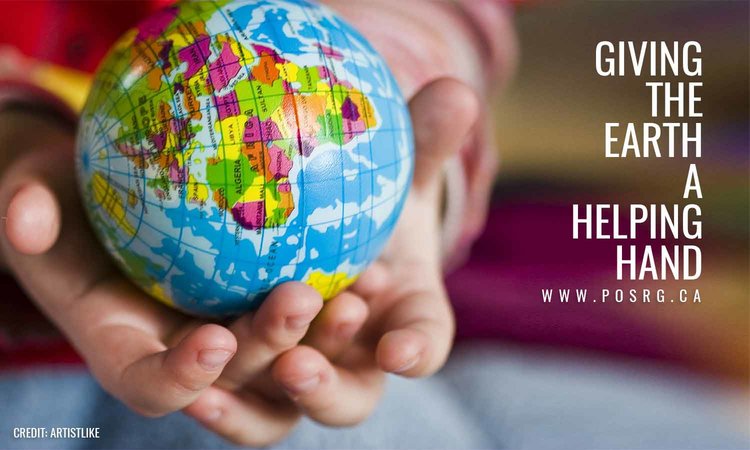
Many more people are becoming aware of measures to manage e-waste, and are adopting the philosophy of “Reduce, Reuse, Recycle.”
- Reducing – Manage your resources wisely — and well. Regularly maintain your equipment and appliances to extend their useful life. Doing this has an added bonus: you don’t have to spend on new products constantly, saving households and residents downtime and costs for replacement.
- Reusing – One person’s (or business’) used electronics can be another’s treasure. If you no longer have need for a certain device but it is still functional, sell (or donate) it to someone else who can find a use for it. Or, sell it to an organization that refurbishes items and resells them to consumers who don’t require the latest model.
- Recycling – It’s time to send a device to a recycling centre when it reaches its shelf life and can no longer be repaired. There are various regulated e-waste recycling centres spread across Canada’s nine provinces. Another option is to take advantage of give- or send-back programs offered by certain manufacturing companies (like Samsung, Dell, and Apple). Contact the manufacturer to find out if they run such a program.
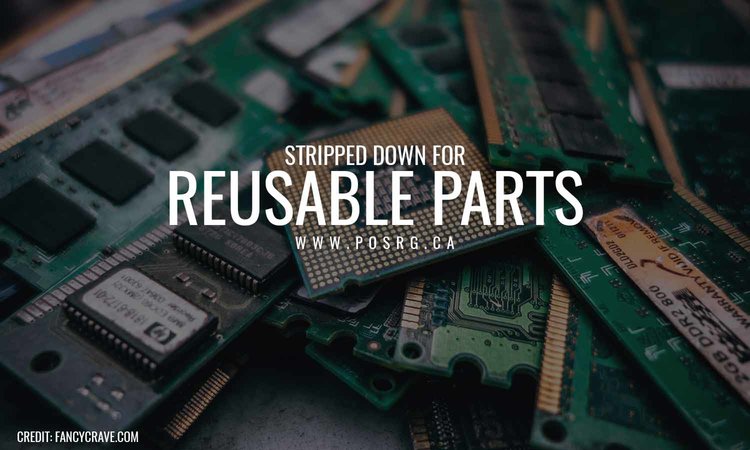
The Processes Involved in e-Waste Recycling
E-waste recycling is a complex (but obviously worthwhile) process, involving several labour-intensive steps. The overall system varies, depending on the items sent for recycling and the equipment needed.
- Collection – Recycling entities (whether recycling centres or the manufacturers themselves) have designated drop-off points where they collect e-waste. Items are gathered and then transported to a separate recycling facility.
- Disassembly – This step involves manually sorting products and removing specific parts, like batteries. Items are dismantled and placed into one of two categories: for reuse or for recycling.
- Reduction (or Shredding) – After having been disassembled, e-waste is broken down to smaller pieces via a two-part shredding process. To ready them for further sorting, particles are broken down to no larger than 100 millimeters.
- Separation
- Over-band magnet separation – Using an over-band magnet, magnetic components (like steel and iron) are removed.
- Metallic and non-metallic separation – Machines sort the metals like aluminum, copper, brass, and circuit boards from the non-metallic components.
- Water separation – Using water, the non-metallic particles, either plastic or glass, are separated from each other.
- Preparation – After the separation process, each separate material is further processed to prepare it for sale as recycled material or to be reused (by manufacturers) in the production of new devices.
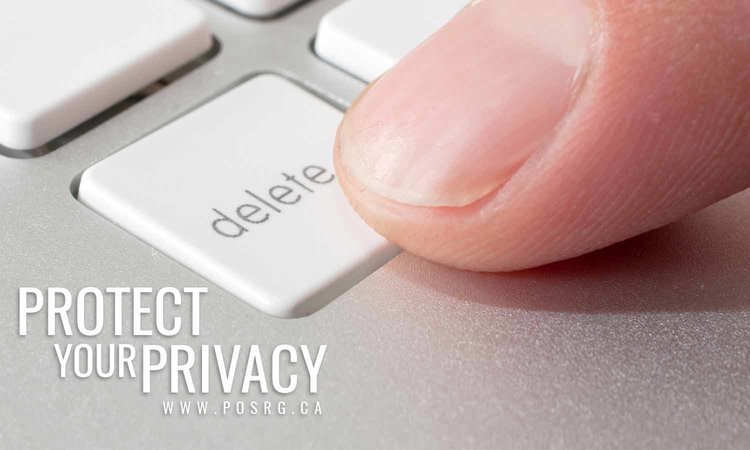
Preparing Items for Recycling
Before you send certain items to your recycling centre of choice, there are a couple of things you should consider:
- Privacy – Protect your privacy by deleting any sensitive information your device (specifically computers and mobile phones) may contain. Note: the goal is permanent wipe. Emptying the recycle bin or formatting is not enough, consult a manual or use third-party software to completely wipe your hard drive of sensitive data. Make sure to remove:
- Contacts and contact information (from both phone and email)
- Phone messages
- Files and documents (including those in the recycle bin)
- Software
- Payment information
- Safety – Transport large equipment or appliances safely. Devices like screens, computer monitors, and televisions can break easily if mishandled. Use protective gear (like heavy duty gloves) to safely move equipment or contact professional movers for help.
It may be a long way before the impact of garbage and e-waste can be fully resolved; but every step counts towards helping the environment, and preserving our planet’s future. Responsible recycling makes a difference.
If you’re looking to have your point-of-sale system refurbished or recycled, contact Point of Sale Remarketing Group. We can extend the life of your POS systems or recycle them for you. Call us at (905) 332-8809 or fill in this form for any POS-related inquiries.

